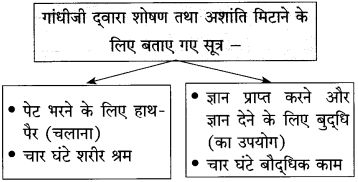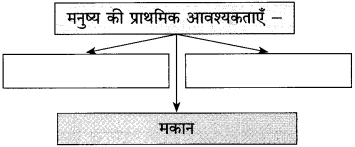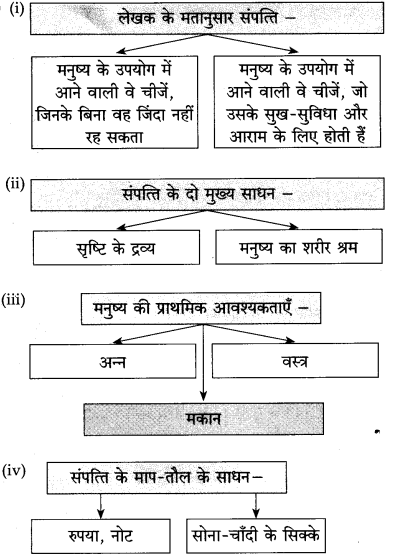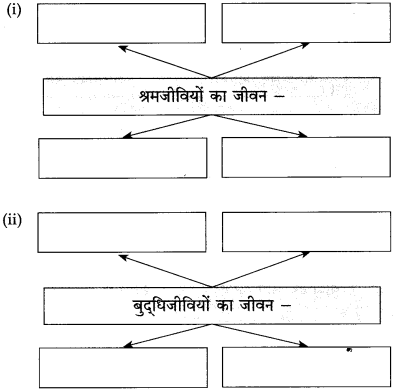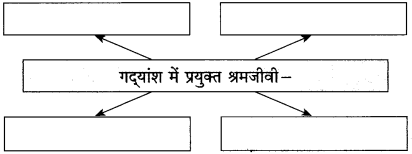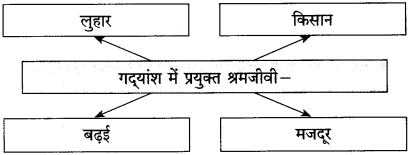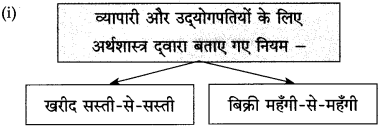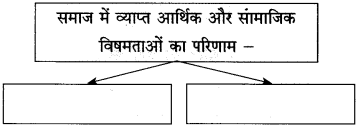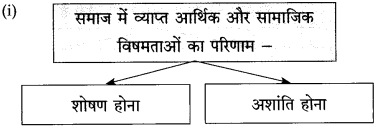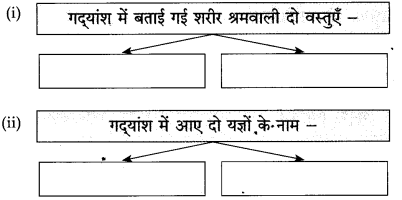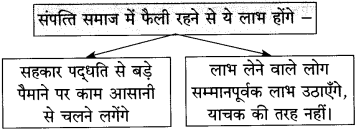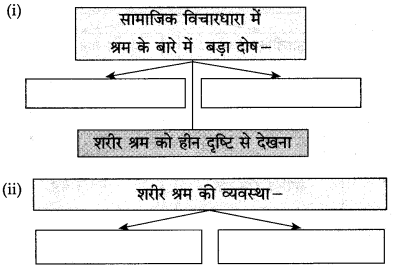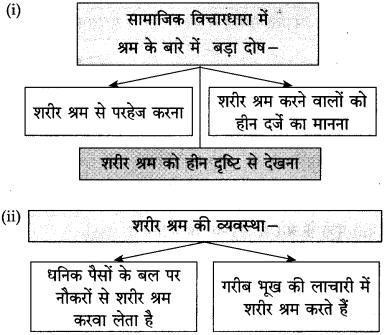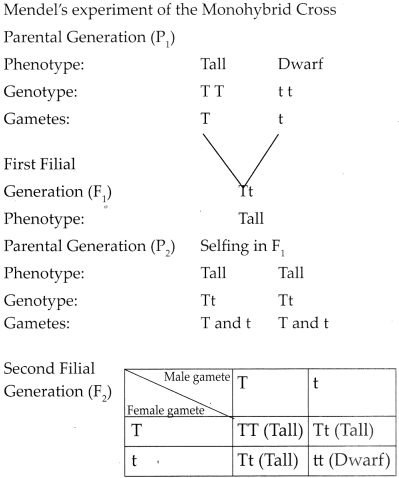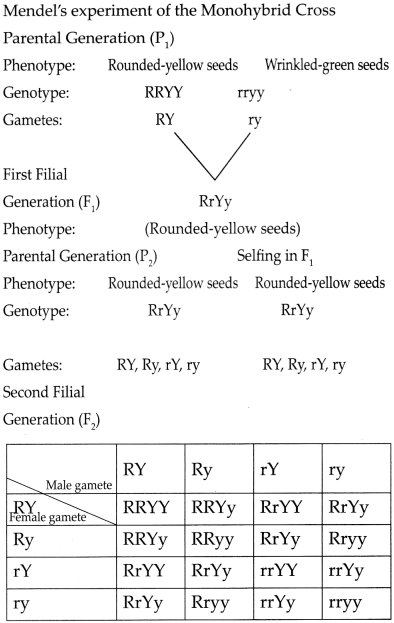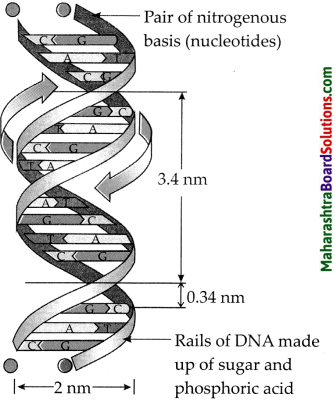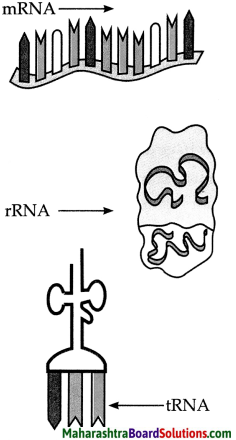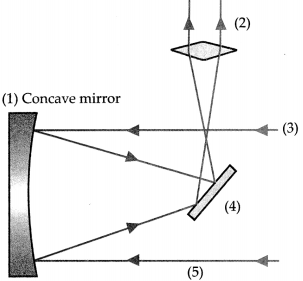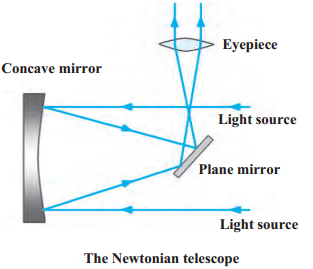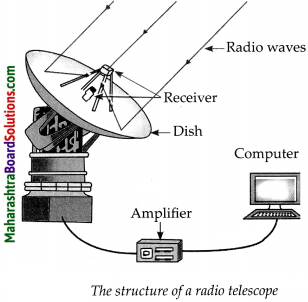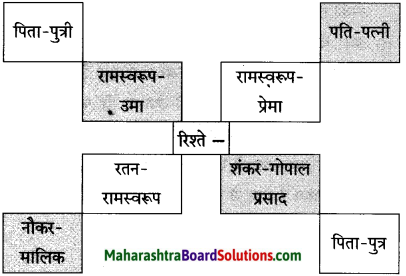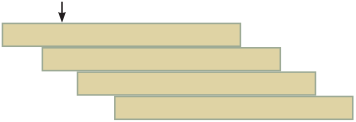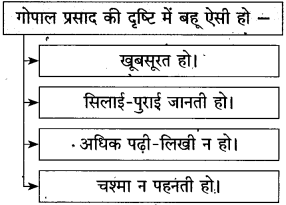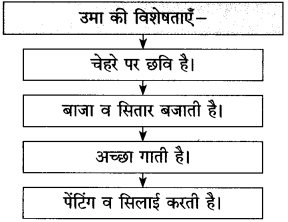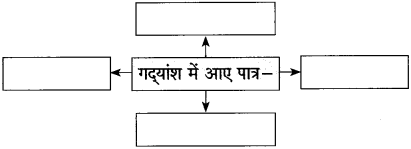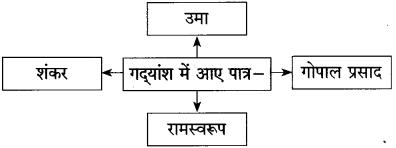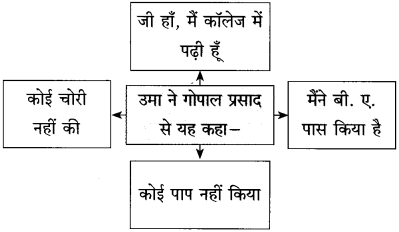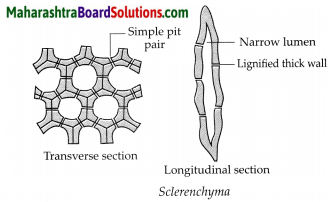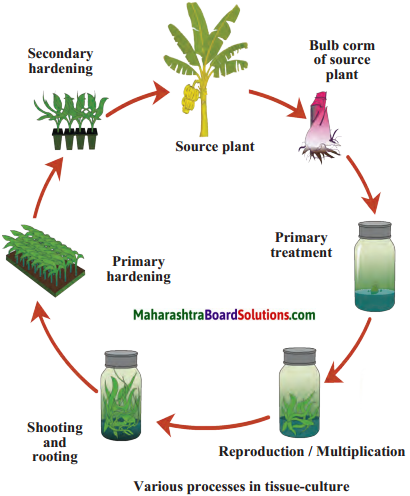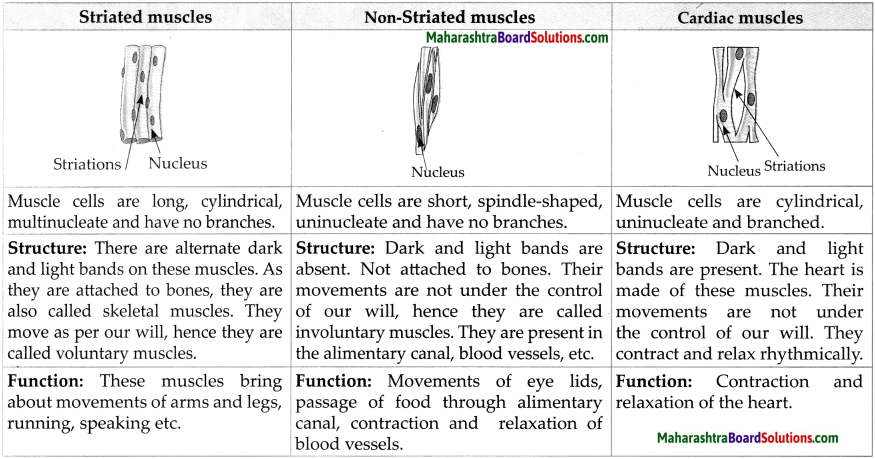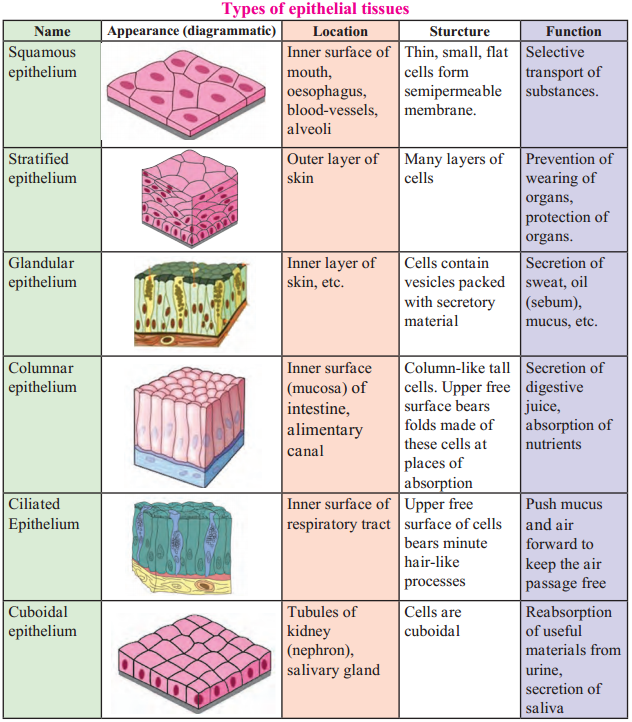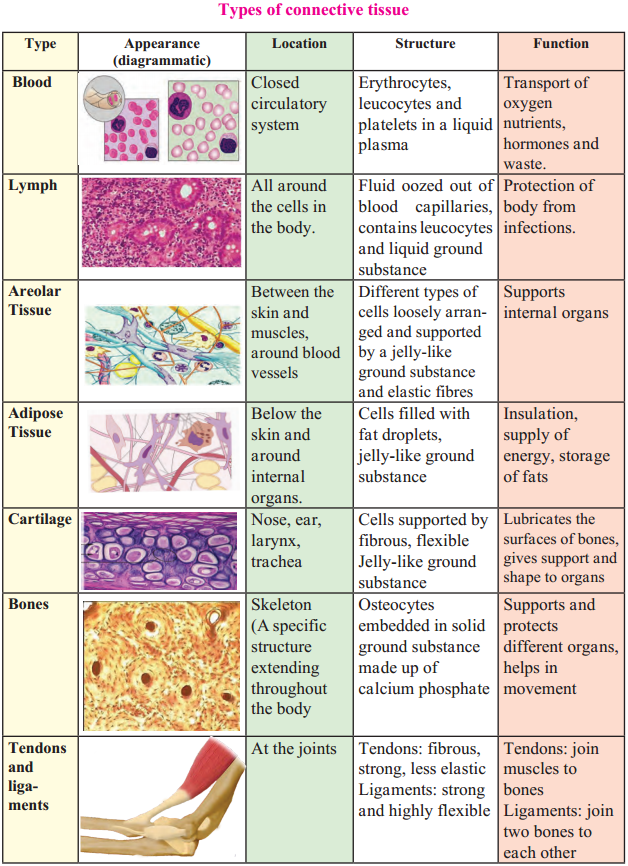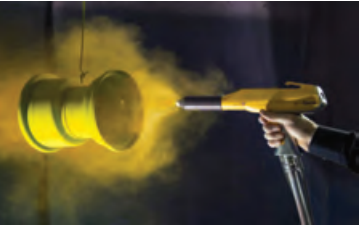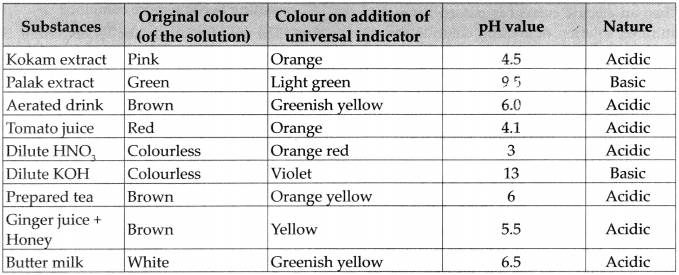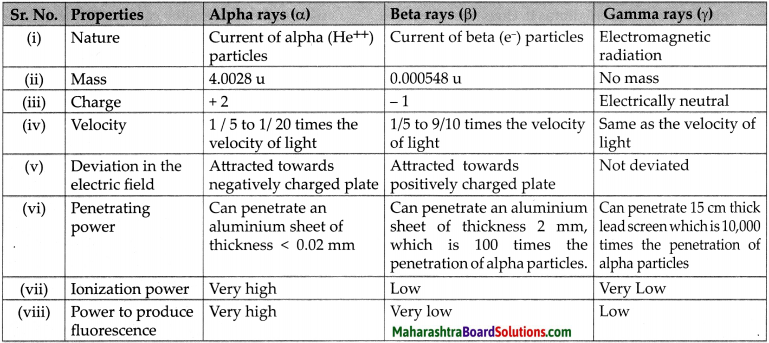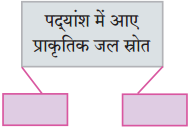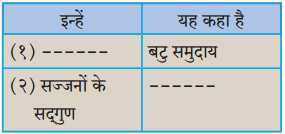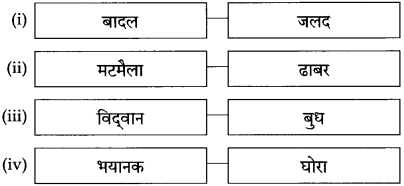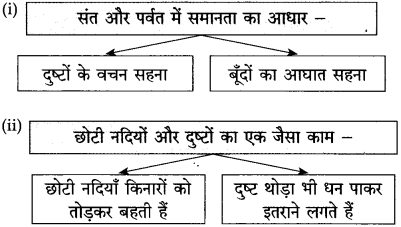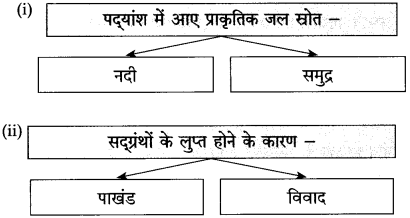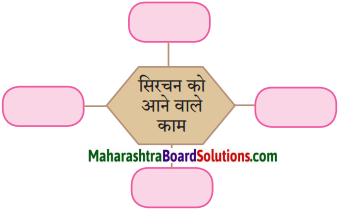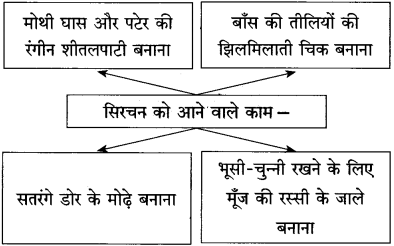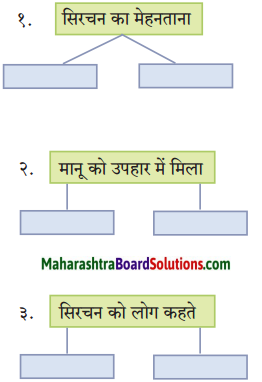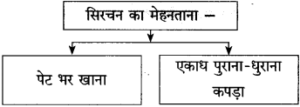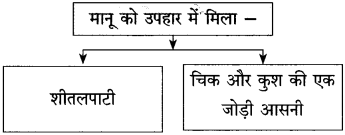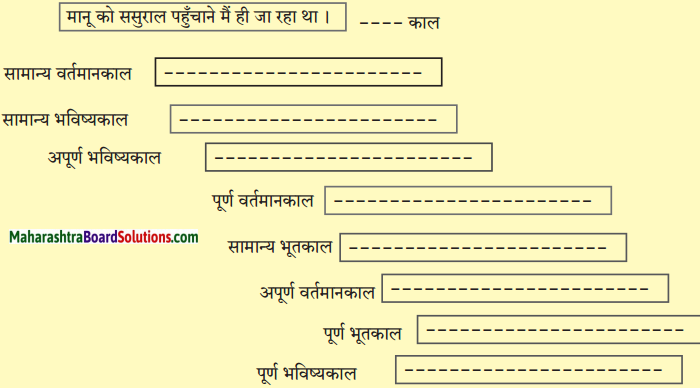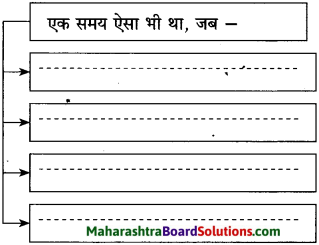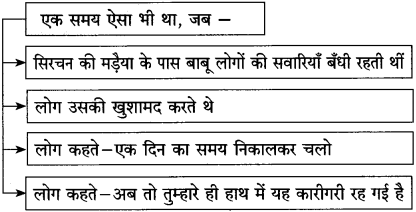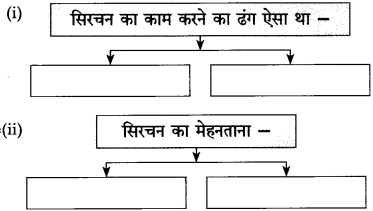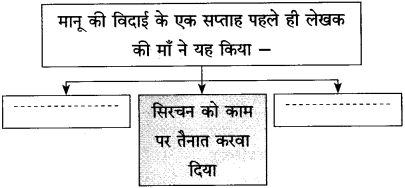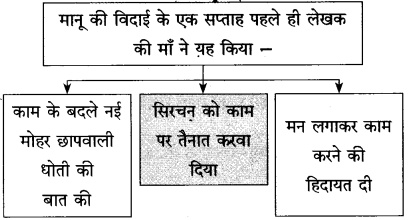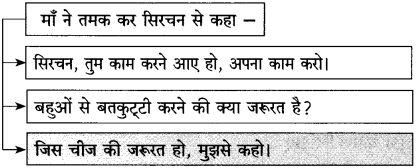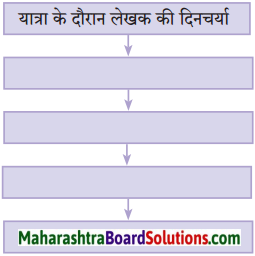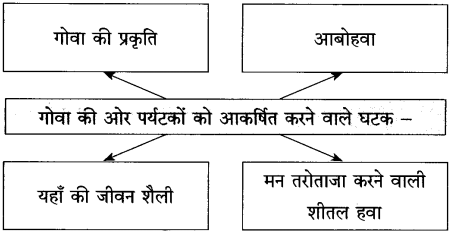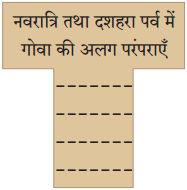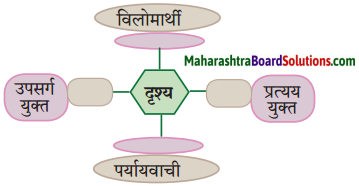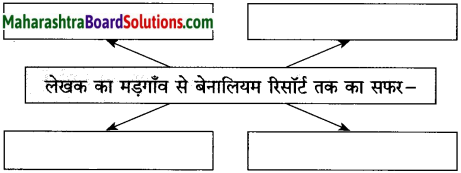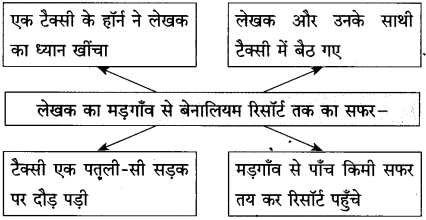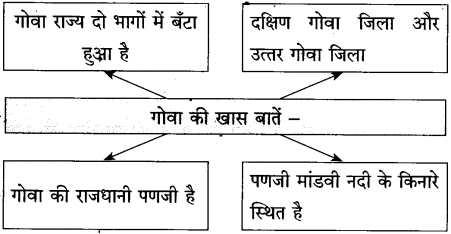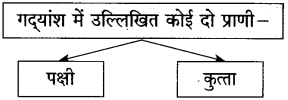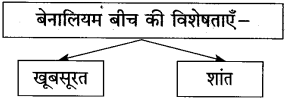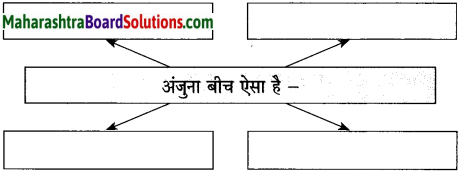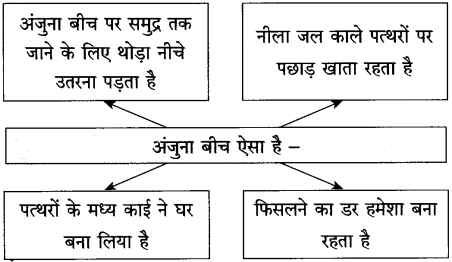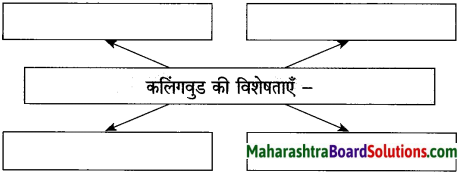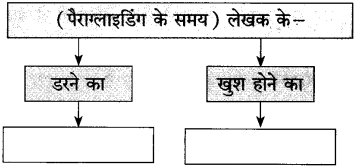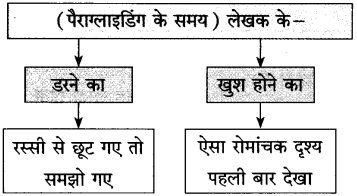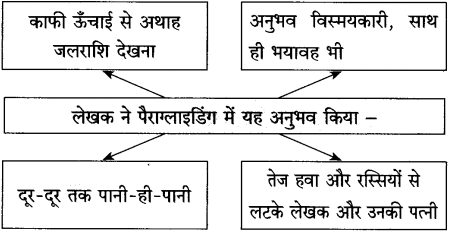Balbharti Maharashtra State Board Class 10 Hindi Solutions Chapter 8 अपनी गंध नहीं बेचूँगान Notes, Textbook Exercise Important Questions, and Answers.
Maharashtra State Board Class 10 Hindi Chapter 8 अपनी गंध नहीं बेचूँगा
Hindi Lokbharti 10th Std Digest Chapter 8 अपनी गंध नहीं बेचूँगा Textbook Questions and Answers
कृति
कृतिपत्रिका के प्रश्न 2 (अ) तथा प्रश्न 2 (आ) के लिए
सूचना के अनुसार कृतियाँ कीजिए :
प्रश्न 1.
कृति पूर्ण कीजिए:

उत्तर:
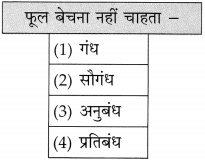
प्रश्न 2.
लिखिए :
(i) फूल को बिक जाने से भी बेहतर लगता
(ii) फूल के अनुसार उसे तोड़ने का पहला अधिकार
उत्तर:
(i) फूल को बिक जाने से भी बेहतर लगता है – मर जाना।
(ii) फूल के अनुसार उसे तोड़ने का पहला अधिकार डाली, कोंपल और काँटों को है।
प्रश्न 3.
कृति पूर्ण कीजिए:
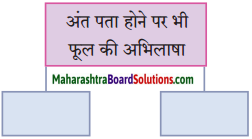
उत्तर:
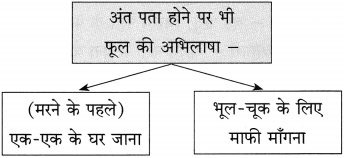
प्रश्न 4.
सूची बनाइए:
इनका फूल से संबंध है –
– – – – – – – – – – – – – – –
– – – – – – – – – – – – – – –
– – – – – – – – – – – – – – –
– – – – – – – – – – – – – – –
उत्तर:
(i) उपवन:
(ii) डाली
(iii) कोंपल
(iv) काँटे।
![]()
प्रश्न 5.
कारण लिखिए :
(i) फूल अपनी सौगंध नहीं बेचेगा – – – – – – – – – – – – – – –
(ii) फूल को मौसम से कुछ लेना नहीं है – – – – – – – – – – – – – – –
उत्तर:
(i) अपनी गंध न बेचने की सौगंध फूल का संस्कार बन गई है, इसलिए फूल अपनी सौगंध नहीं बेचेगा।
(i) फूल को मौसम से कुछ लेना-देना नहीं है – उसे अपने अस्तित्व के लिए कुछ भी पाने की इच्छा नहीं है। इसलिए कैसा भी मौसम हो, उसे कोई फर्क नहीं पड़ता।
प्रश्न 6.
‘दाता होगा तो दे देगा, खाता होगा तो खाएगा’ इस पंक्ति से स्पष्ट होने वाला अर्थ लिखिए।
उत्तर:
फूल को केवल अपने स्वाभिमान से मतलब है। उसे किसी चीज को पाने अथवा खो जाने की चिंता नहीं है। जो मिलना होगा, मिलेगा और जो नुकसान होगा, होगा। उसे उसकी चिंता नहीं है।
प्रश्न 7.
निम्नलिखित मुद्दों के आधार पर पद्य विश्लेषण कीजिए :
1. रचनाकार का नाम
2. रचना का प्रकार
3. पसंदीदा पंक्ति
4. पसंदीदा होने का कारण
5. रचना से प्राप्त संदेश/प्रेरणा
उत्तर:
1. रचनाकार का नाम → बालकवि बैरागी।
2. रचना की विधा → गीत।
3. पसंद की पंक्ति → चाहे सभी सुमन बिक जाएँ,
चाहे ये उपवन बिक जाएँ
चाहे सौ फागुन बिक जाएँ
पर मैं गंध नहीं बेचूंगा।
4. पंक्तियाँ पसंद होने का कारण → इन पक्तियों में फूल हर हालत में जीवन में अपने स्वाभिमान को सर्वोपरि मानता है। इसके लिए उसे कोई भी त्याग करना पड़े, तो वह इसके लिए तैयार है, पर वह अपने स्वाभिमान को हर हालत में बनाए रखना चाहता है।
5. रचना से प्राप्त संदेश/प्रेरणा → प्रस्तुत रचना से यह संदेश मिलता है कि स्वाभिमान मनुष्य की सबसे बड़ी थाती है। हमें हर हालत में इसकी रक्षा करनी चाहिए। यदि स्वाभिमान की रक्षा के लिए हमें अपना सर्वस्व निछावर कर देना पड़े, तो भी हँसते-हँसते अपना सब कुछ त्याग देना चाहिए। प्रस्तुत पंक्तियों से हमें यही प्रेरणा मिलती है। (विद्यार्थी अपनी पसंदीदा पंक्ति लिखें।)
![]()
Hindi Lokbharti 10th Textbook Solutions Chapter 8 अपनी गंध नहीं बेचूँगा Additional Important Questions and Answers
पद्यांश क्र. 1
प्रश्न. निम्नलिखित पठित पद्यांश पढ़कर दी गई सूचनाओं के अनुसार कृतियाँ कीजिए :
कृति 1 : (आकलन)
प्रश्न 1.
आकृति पूर्ण कीजिए :
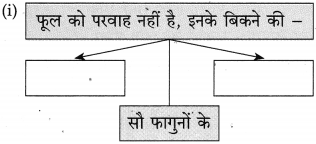
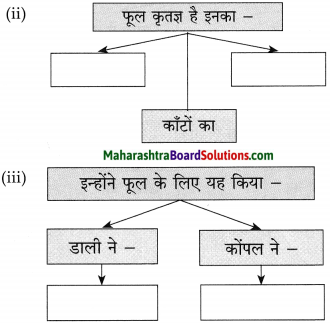
उत्तर:
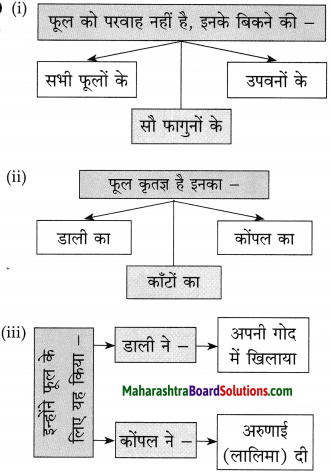
![]()
प्रश्न 2.
जोड़ियाँ मिलाइए :
(i) सुमन – पँखुरी
(ii) काँटे – सौगंध
(iii) मालिन – उपवन
(iv) संस्कार – चौकी
उत्तर:
(i) सुमन – उपवन
(ii) काँटे – चौकी
(iii) मालिन – पँखुरी
(iv) संस्कार – सौगंध
प्रश्न 3.
उत्तर लिखिए :
(i) फूल ‘सौगंध’ न बेचने की बात इन्हें संबोधित करते हुए कहता है।
उत्तर:
(i) अपने ऊपर मँडराने वालों और अपना मोल लगाने वालों को फूल ‘सौगंध’ न बेचने की बात संबोधित करते हुए कहता है।
प्रश्न 4.
कारण लिखिए :
(i) फूल डाली, कोंपल और काँटों को स्वयं को नोचने-तोड़ने का अधिकार देता है –
उत्तर:
(i) फूल डाली, कोंपल और काँटों का कृतज्ञ है, इसलिए वह इन्हें अपने आप को नोचने-तोड़ने का अधिकार देता है।
प्रश्न 5.
उत्तर लिखिए : (पद्यांश में आया)
(i) एक भारतीय महीने का नाम – ………………………………..
(ii) एक प्रसिद्ध पौराणिक चरित्र, जिनके नाम के साथ रेखा’ शब्द जोड़कर उदाहरण दिया जाता है – ………………………………..
(iii) फूलों के बगीचे में फूलों के पौधे लगाने और उनकी सेवा करने वाले व्यक्ति की पत्नी – ………………………………..
(iv) फूलों की महक के अर्थ में प्रयुक्त शब्द – ………………………………..
उत्तर:
(i) एक भारतीय महीने का नाम – फागुन।
(ii) एक प्रसिद्ध पौराणिक चरित्र, जिनके नाम के साथ ‘रेखा शब्द जोड़कर उदाहरण दिया जाता है- लछमन (लक्ष्मण), लक्ष्मण रेखा।
(iii) फूलों के बगीचे में फूलों के पौधे लगाने और उनकी सेवा करने – वाले व्यक्ति की पत्नी – मालिन।
(iv) फूलों की महक के अर्थ में प्रयुक्त शब्द – गंध।
![]()
कृति 2 : (शब्द संपदा)
प्रश्न 1.
निम्नलिखित शब्दों के अर्थ लिखिए :
(i) अरुणाई
(ii) चौकी
(iii) गंध
(iv) सौगंध
उत्तर:
(i) अरुणाई -लालिमा
(ii) चौकी – पहरा
(iii) गंध -सुगंध
(iv) सौगंध – कसम।
प्रश्न 2.
निम्नलिखित शब्द समूहों के लिए एक-एक शब्द लिखिए :
(i) वृक्ष की नई और कोमल पत्तियाँ =
(ii) किसी वस्तु के ऊपर चारों ओर घूमते हुए उड़ना =
उत्तर :
(i) वृक्ष की नई और कोमल पत्तियाँ – कोंपल
(ii) किसी वस्तु के ऊपर चारों ओर घूमते हुए उड़ना – मँडराना।
कृति 3 : (सरल अर्थ)
प्रश्न.
उपर्युक्त पद्यांश की ‘जिस डाली ने ——— रिश्ते जोड़े’ पंक्तियों का सरल अर्थ 25 से 30 शब्दों में लिखिए।
उत्तर:
फूल कहता है कि पौधे की जिस डाल ने उसे अपनी गोद में खिलाया था, जिन कोंपलों ने उसे लालिमा प्रदान की थी और जिन काँटों ने लक्ष्मणजी की तरह पहरा देकर उसे तोड़े जाने से बचाया था, उन्हें वह कभी भूल नहीं सकता। उनका वह ऋणी है और उस पर पहला अधिकार इन्हीं का है। वे चाहे उसे नोचें या तोड़ें, वह उफ तक नहीं करेगा। वह कहता है कि वे चाहे मुझे तोड़कर किसी मालिन को दे दें, तो भी मुझे कोई आपत्ति नहीं है।
पद्यांश क्र. 2
प्रश्न. निम्नलिखित पठित पद्यांश पढ़कर दी गई सूचनाओं के अनुसार कृतियाँ कीजिए :
कृति 1: (आकलन)
प्रश्न 1.
आकृति पूर्ण कीजिए :
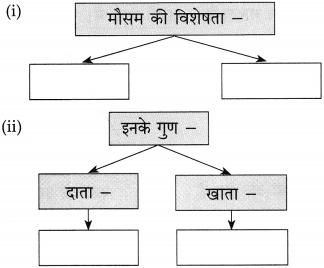
उत्तर:
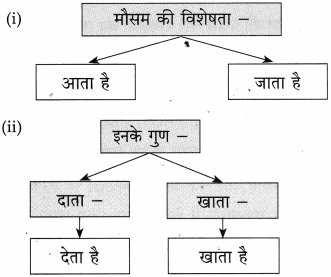
![]()
प्रश्न 2.
कारण लिखिए :
(i) पिचकारी का जादू-टोना फूल पर कोई अंतर नहीं लाएगा –
उत्तर:
(i) पिचकारी का जादू-टोना फूल पर कोई अंतर नहीं लाएगा – फूल को कृत्रिम फुहारों की कामना नहीं है। इसलिए पिचकारी का जादू-टोना फूल पर कोई अंतर नहीं लाएगा।
प्रश्न 3.
आकृति पूर्ण कीजिए:
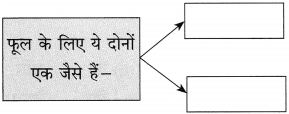
उत्तर:

कृति 2 : (शब्द संपदा)
प्रश्न 1.
पद्यांश में प्रयुक्त शब्द-युग्म ढूँढकर लिखिए :
(i) ………………………………
(ii) ………………………………
(iii) ………………………………
(iv) ………………………………
उत्तर:
(i) आएगा-जाएगा
(ii) रोना-धोना
(iii) जादू-टोना
(iv) पल-पल।
प्रश्न 2.
निम्नलिखित शब्दों के समानार्थी शब्द लिखिए :
(i) भौंरा = ………………………………
(ii) सुर = ………………………………
(iii) दाम = ………………………………
(iv) कोमल = ………………………………
उत्तर:
(i) भौंरा = भ्रमर
(ii) सुर = स्वर
(iii) दाम = मूल्य
(iv) कोमल = मुलायम।
![]()
कृति 3 : (सरल अर्थ)
प्रश्न.
प्रस्तुत पद्यांश की अंतिम चार पंक्तियों का सरल अर्थ 25 से 30 शब्दों में लिखिए।
उत्तर:
चाहे फूल की कोमल-कोमल पंखुड़ियों पर भौंरों के गुंजन का सरगम सुनाई देता हो अथवा पतझड़ का मौसम हो, और वह मुरझाई हुई दशा में हो या उस पर कृत्रिम फुहारें डालकर उसे सांत्वना दी जाए, उस पर कोई फर्क नहीं पड़ता। फूल अपनी बोली लगाने वालों और पल-पल अपनी कीमतें आँकने वालों को संबोधित करते हुए कहता है कि मैंने अपने आप से अपने स्वाभिमान का अनुबंध कर लिया है और यह ठान लिया है कि मैं अपने स्वाभिमान पर कभी आँच नहीं आने दूंगा। मैं उस अनुबंध को किसी भी हालत में दाँव पर नहीं लगा सकता अर्थात मैं उसका कभी सौदा नहीं कर सकता। फूल कहता है कि वह अपनी सुगंध कभी नहीं बेच सकता।
पयांश क्र. 3
प्रश्न. निम्नलिखित पठित पद्यांश पढ़कर दी गई। सूचनाओं के अनुसार कृतियाँ कीजिए :
कृति 1 : (आकलन)
प्रश्न 1.
दो ऐसे प्रश्न बनाकर लिखिए, जिनके उत्तर निम्नलिखित शब्द हों :
(i) मन ने
(ii) पवन के।
उत्तर:
(i) तन पर किसने प्रतिबंध लगा दिया?
(ii) फूल एक-एक के घर किसके साथ जाएगा?
प्रश्न 2.
लिखिए :
(i) फूल झर जाना चाहता है ……………………………|
उत्तर:
(i) फूल झर जाना चाहता है – अपनी माटी में।
प्रश्न 3.
आकृति पूर्ण कीजिए :
(i) फूल इस तरह झर जाएगा
(ii) भूल-चूक की माफी यह लेगी –
(iii) तब मंडी यह समझेगी –
(iv) इसको इसका अंत पता है –
उत्तर:
(i) फूल इस तरह झर जाएगा – पंखुरी-पंखुरी गिरकर
(ii) भूल-चूक की माफी यह लेगी – फूल की गंध कुमारी
(iii) तब मंडी यह समझेगी – खुद्दारी किसको कहते हैं।
(iv) इसको इसका अंत पता है – फूल को अपना
![]()
कृति 2 : (शब्द संपदा)
प्रश्न 1.
पद्यांश में प्रयुक्त शब्द-युग्म ढूँढ़कर लिखिए :
(i) ………………………………….
(ii) ………………………………….
उत्तर:
(i) एक-एक
(ii) भूल-चूक।
प्रश्न 2.
निम्नलिखित शब्दों के समानार्थी शब्द लिखिए :
(i) पवन = ………………………………….
(ii) तन = ………………………………….
(iii) घर = ………………………………….
(iv) दिन = ………………………………….
उत्तर:
(i) पवन = हवा
(ii) तन = शरीर
(iii) घर = मकान
(iv) दिन = दिवस।
कृति 3 : (सरल अर्थ)
प्रश्न.
प्रस्तुत पद्यांश की प्रथम चार पंक्तियों का सरल अर्थ 25 से 30 शब्दों में लिखिए।
उत्तर:
फूल कहता है कि इस संसार में जिसका भी जन्म होता है, एक-न-एक दिन उसका अंत होना (मरना) निश्चित है। वह कहता है कि यह बात मुझे अच्छी तरह मालूम है कि एक दिन मैं भी पंखुड़ीपंखुड़ी करके झर जाऊँगा और मेरा अंत हो जाएगा। पर इसके पहले मैं हवा के साथ उड़कर वातावरण में फैलकर एक-एक (फूल) के पास ३ जाऊँगा और मेरी सुगंध उनसे जाने-अनजाने में किए की माफी मांगेगी।
फूल कहता है कि उस दिन बाजार और बाजार में खरीद-फरोख्त करने वाले लोगों को यह बात समझ में आएगी कि खुद्दारी अर्थात स्वाभिमान क्या होता है और इसके सम्मान के लिए लोग हर प्रकार का त्याग करने के लिए क्यों तत्पर रहते हैं।
भाषा अध्ययन (व्याकरण)
प्रश्न. सूचनाओं के अनुसार कृतियाँ कीजिए :
1. शब्द भेद :
अधोरेखांकित शब्दों का शब्दभेद पहचानकर लिखिए :
(i) फूल की अरुणाई देखने योग्य थी।
(ii) भँवरे फूलों पर मँडराते हैं।
उत्तर :
(i) अरुणाई – भाववाचक संज्ञा।
(ii) भँवरे – जातिवाचक संज्ञा।
![]()
2. अव्यय :
निम्नलिखित अव्ययों का अपने वाक्यों में प्रयोग कीजिए :
(i) सामने
(ii) तरफ।
उत्तर :
(i) फूल एक-एक के सामने जाएगा।
(ii) मालिन ने फूल की तरफ देखा।
3. संधि :
कृति पूर्ण कीजिए :
| संधि शब्द | संधि विच्छेद | संधि भेट |
| ………………… | यथा + अर्थ | ………………… |
| अथवा | ||
| नमस्ते | ………………… | ………………… |
उत्तर:
| संधि शब्द | संधि विच्छेद | संधि भेट |
| यथार्थ | यथा + अर्थ | स्वर संधि |
| अथवा | ||
| नमस्ते | नमः + ते | विसर्ग संधि |
4. सहायक क्रिया :
निम्नलिखित वाक्यों में से सहायक क्रिया पहचानकर उसका मूल रूप लिखिए :
(i) बिकने से बेहतर है मर जाऊँ।
(ii) मन ने तन पर प्रतिबंध लगा दिया।
उत्तर:
सहायक क्रिया – मूल रूप
(i) जाऊँ – जाना
(ii) दिया – देना
![]()
5. प्रेरणार्थक क्रिया :
निम्नलिखित क्रियाओं के प्रथम प्रेरणार्थक और द्वितीय प्रेरणार्थक रूप लिखिए :
(i) रोना
(ii) उड़ना।
उत्तर:
क्रिया प्रथम प्रेरणार्थक रूप दुवितीय प्रेरणार्थक रूप
(i) रोना – रुलाना – रुलवाना
(ii) उड़ना – उड़ाना – उड़वाना
6. मुहावरे :
प्रश्न 1.
निम्नलिखित मुहावरों का अर्थ लिखकर वाक्य में प्रयोग कीजिए :
(i) चैन न मिलना
(ii) झेंप जाना।
उत्तर :
(i) चैन न मिलना।
अर्थ : बेचैनी अनुभव करना।
वाक्य : इलाके में चोरी की बढ़ती घटनाओं से पुलिस को चैन नहीं मिल रहा था।
(ii) झेंप जाना।
अर्थ : लज्जित होना, शरमाना।
वाक्य : हिसाब-किताब में गड़बड़ी पकड़े जाने पर मुंशी जी झेंप गए।
![]()
प्रश्न 2.
अधोरेखांकित वाक्यांशों के लिए उचित मुहावरे का चयन करके वाक्य फिर से लिखिए : (थर-थर काँपना, नजर आना, दृष्टि फेरना)
(i) चोर पुलिस के डर से बहुत अधिक काँप रहा था।
(ii) आगरा के किले की ऊपरी मंजिल से ताजमहल का गुंबद दिखाई देता है।
उत्तर:
(i) चोर पुलिस के डर से थर-थर काँप रहा था।
(ii) आगरा के किले की ऊपरी मंजिल से ताजमहल का गुंबद नजर आता है।
7. कारक:
निम्नलिखित वाक्यों में प्रयुक्त कारक पहचानकर उसका भेद लिखिए :
(i) अच्छा हो मर कर अपनी माटी में झर जाऊँ।
(ii) चाहे जिस मालिन से मेरी पंखुरियों के रिश्ते जोड़ें।
उत्तर:
(i) माटी में – अधिकरण कारक।
(ii) मालिन से – करण कारक।
8. विरामचिह्न :
निम्नलिखित वाक्यों में यथास्थान उचित विरामचिह्नों का प्रयोग करके वाक्य फिर से लिखिए :
(i) मौसम से मुझको क्या लेना है वह तो आएगा – जाएगा
(ii) अच्छा तो आप मुझे अपनी गंध बेचने के लिए कह रहे हैं
उत्तर :
(i) मौसम से मुझको क्या लेना है, वह तो आएगा-जाएगा।
(ii) अच्छा! तो आप मुझे अपनी गंध बेचने के लिए कह रहे हैं।
9. काल परिवर्तन :
निम्नलिखित वाक्यों का सूचना के अनुसार काल परिवर्तन कीजिए :
(i) मैं गंध नहीं बेचूंगा। (सामान्य भूतकाल)
(ii) मुझको मेरा अंत पता है। (पूर्ण भूतकाल)
उत्तर :
(i) मैंने गंध नहीं बेची।
(ii) मुझको मेरा अंत पता था।
10. वाक्य भेद :
प्रश्न 1.
निम्नलिखित वाक्यों का रचना के आधार पर भेद पहचानकर लिखिए :
(i) एक ओर भौरे का गुंजार है और दूसरी ओर पतझड़।
(ii) मैं वह सौगंध नहीं बेचूंगा, जो मेरा संस्कार बन गई।
उत्तर :
(i) संयुक्त वाक्य
(ii) मिश्र वाक्य।
![]()
प्रश्न 2.
निम्नलिखित वाक्यों का अर्थ के आधार पर दी गई सूचना के अनुसार परिवर्तन कीजिए :
(i) फूल अपनी गंध नहीं बेचेगा। (विस्मयादिबोधक वाक्य)
(ii) फूल एक-एक के घर जाएगा। (संदेहबोधक वाक्य)
उत्तर :
(i) अच्छा ! फूल अपनी गंध नहीं बेचेगा !
(ii) फूल शायद एक-एक के घर जाए।
11. वाक्य शुद्धिकरण :
निम्नलिखित वाक्य शुद्ध करके फिर से लिखिए :
(i) उस दीन ये मंडी समझेगा।
(ii) तब दूनिया उसके पाँव पर पड़ेगी।
उत्तर:
(i) उस दिन ये मंडी समझेगी।
(ii) तब दुनिया उसके पाँव पड़ेगी।
अपनी गंध नहीं बेचूँगा Summary in Hindi
विषय-प्रवेश :
स्वाभिमान मनुष्य की थाती है। जिस व्यक्ति में स्वाभिमान की भावना नहीं होती, उसका अपना कोई अस्तित्व नहीं होता। स्वाभिमानी लोग अपने स्वाभिमान की रक्षा के लिए अपना सब कुछ गँवा देते हैं, पर अपने स्वाभिमान पर आँच नहीं आने देते। प्रस्तुत कविता में कवि ने एक ऐसे ही फूल का वर्णन किया है, जो अपने स्वाभिमान को बनाए रखने के लिए अपना सब कुछ निछावर करने के लिए तत्पर है, पर किसी भी हालत में अपना स्वाभिमान छोड़ने के लिए तैयार नहीं है। कवि ने इस कविता के द्वारा फूल के इस गुण को मनुष्य को भी अपनाने और स्वाभिमानी रहने की प्रेरणा दी है।
अपनी गंध नहीं बेचूँगा कविता का सरल अर्थ
1. चाहे सभी सुमन …………………………. सौगंध नहीं बेचूंगा।
स्वाभिमानी फूल अपने स्वाभिमान की रक्षा के लिए अपना सब कुछ निछावर करने के लिए तैयार है, पर वह किसी भी हालत में अपने स्वाभिमान पर आँच नहीं आने देना चाहता।
वह कहता है कि चाहे सारे फूल बिक जाएँ, केवल फूल ही नहीं चाहे वे उपवन भी बिक जाएँ, जहाँ सारे फूल उत्पन्न होते हैं। सारी बहार क्यों न बिक जाए, पर वह अपनी सुगंध को, जिसे वह अपना स्वाभिमान मानता है, किसी भी हालत में नहीं बेच सकता।
जिस तरह मनुष्य अपने स्वाभिमान के लिए मर मिट जाता है, पर उस पर आँच नहीं आने देता, उसी तरह यह फूल भी अपनी सुगंध की रक्षा के लिए प्रतिबद्ध है।
फूल कहता है कि पौधे की जिस डाल ने उसे अपनी गोद में खिलाया था, जिन कोंपलों ने उसे लालिमा प्रदान की थी और जिन काँटों ने लक्ष्मणजी की तरह पहरा देकर उसे तोड़े जाने से बचाया था, उन्हें वह कभी भूल नहीं सकता। उनका वह ऋणी है और उस पर पहला अधिकार इन्हीं का है। वे चाहे उसे नोचें या तोड़ें, वह उफ तक नहीं करेगा। वह कहता है कि वे चाहे मुझे तोड़कर किसी मालिन को दे दें, तो भी मुझे कोई आपत्ति नहीं है।
वह चारों ओर से अपने ऊपर नजरें गड़ाने वालों और उसकी कीमत लगाकर उसे बाजार में बेचने वालों से कहता है कि उसने अपनी सुगंध को न बेचने की जो सौगंध खाई है, वह उसका संस्कार बन गई है और वह उसका सौदा कभी नहीं कर सकता। फूल कहता है कि वह अपनी सुगंध कभी नहीं बेच सकता।
2. मौसम से क्या लेना अनुबंध नहीं बेचूंगा।
फूल कहता है कि मौसम, कैसा भी हो, मौसम का उस पर कोई प्रभाव नहीं पड़ता। वह हर स्थिति में अपने आप को स्थिर रखने में सक्षम है। उसे किसी से कुछ भी पाने की आकांक्षा नहीं है। वह लाभ या हानि की कोई परवाह नहीं करता। न उस पर किसी चीज का कोई प्रभाव पड़ता है। और न वह किसी चीज से कभी घबराता है। चाहे उसकी कोमल-कोमल पंखुड़ियों पर भौंरों के गुंजन का सरगम सुनाई देता हो अथवा पतझड़ का मौसम हो, और वह मुरझाई हुई दशा में हो या उस पर कृत्रिम फुहारें डालकर उसे सांत्वना दी जाए, उस पर कोई फर्क नहीं पड़ता।
वह अपनी बोली लगाने वालों और पल-पल अपनी कीमतें आँकने वालों को संबोधित करते हुए कहता है कि मैंने अपने आप से अपने स्वाभिमान का अनुबंध कर लिया है और यह ठान लिया है कि मैं अपने स्वाभिमान पर कभी आँच नहीं आने दूँगा। मैं उस अनुबंध को किसी भी हालत में दाँव पर नहीं लगा सकता अर्थात मैं उसका कभी सौदा नहीं कर सकता। फूल कहता है कि वह अपनी सुगंध कभी नहीं बेच सकता।
3. मुझको मेरा अंत ……………………… वो प्रतिबंध नहीं बेचूंगा।
फूल कहता है कि इस संसार में जिसका भी जन्म होता है, एक-न-एक दिन उसका अंत होना (मरना) निश्चित है। वह कहता है कि यह बात मुझे अच्छी तरह मालूम है कि एक दिन मैं भी पंखुड़ीपंखुड़ी करके झर जाऊँगा और मेरा अंत हो जाएगा। पर इसके पहले मैं हवा के साथ उड़कर वातावरण में फैलकर एक-एक (फूल) के पास जाऊँगा और मेरी सुगंध उनसे जाने-अनजाने में किए की माफी मांगेगी।
फूल कहता है कि उस दिन बाजार और बाजार में खरीद-फरोख्त करने वाले लोगों को यह बात समझ में आएगी कि खुद्दारी अर्थात स्वाभिमान क्या होता है और इसके सम्मान के लिए लोग हर प्रकार का त्याग करने के लिए क्यों तत्पर रहते हैं। फूल कहता है कि किसी के हाथों बिकने से तो अच्छा है कि मैं मर जाऊँ और अपने देश की मिट्टी में मिल जाऊँ। वह कहता है कि मैंने अपनी इच्छा से अपने शरीर पर जो प्रतिबंध लगा लिया है, उस प्रतिबंध को मैं कभी नहीं बेच सकता।
(फूल के इस स्वाभिमान को मनुष्य को भी अपनाना चाहिए और उसे भी किसी लालच में आकर कभी अपना स्वाभिमान बेचना नहीं चाहिए।)
